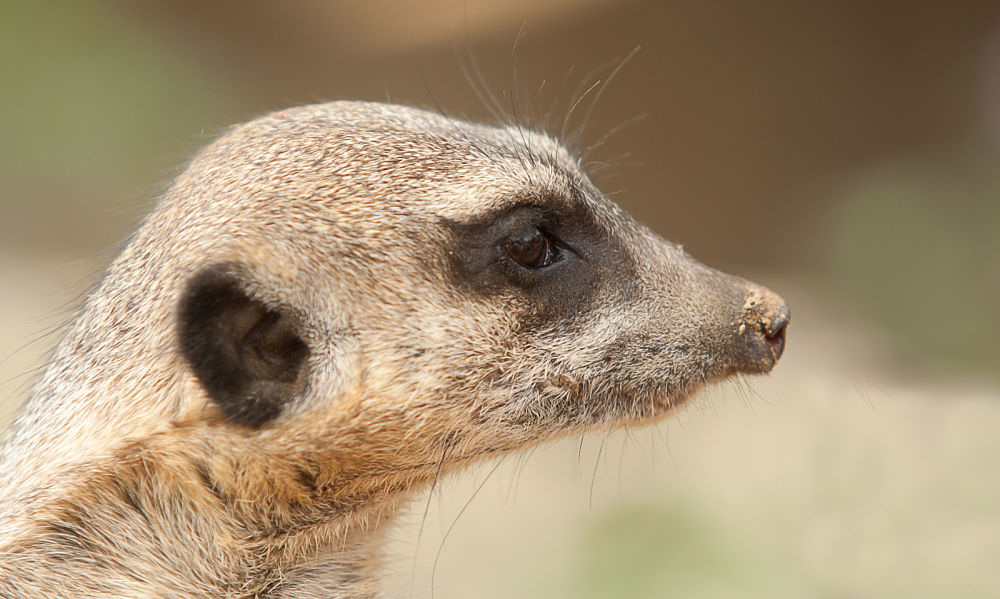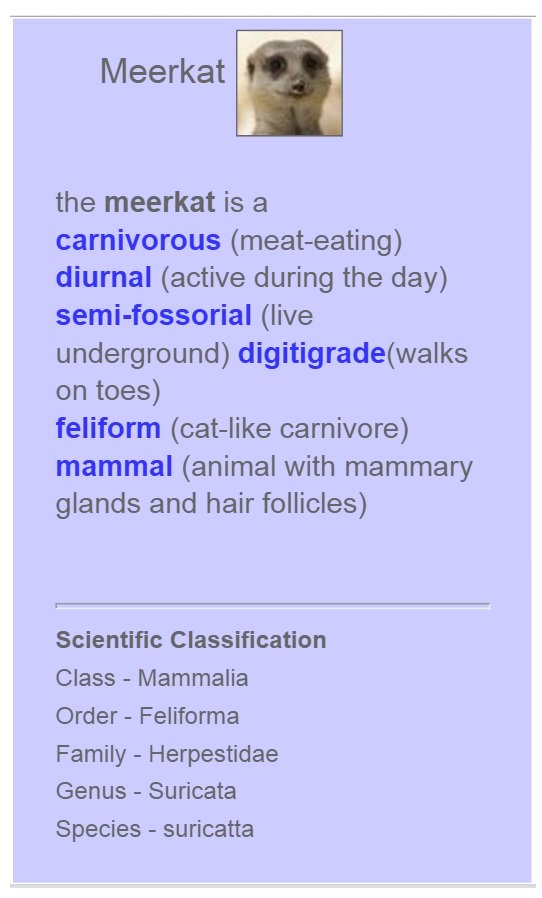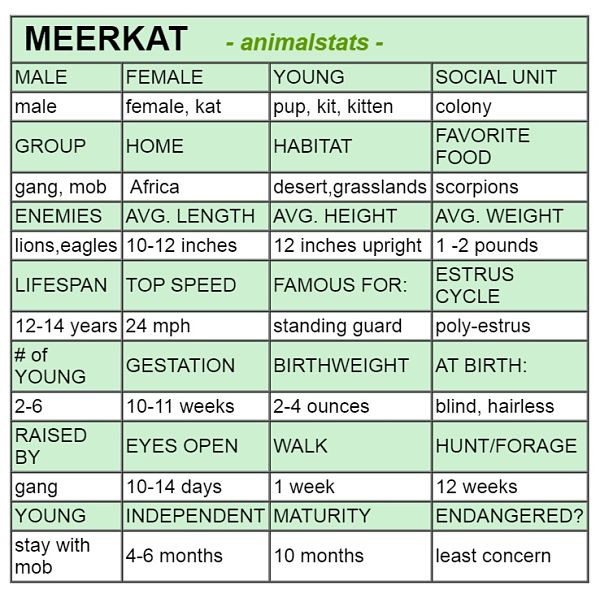meerkat Facts
 Portrait of a Meerkat
Portrait of a MeerkatMeerkats are a small mongoose species known for their intensely watchful nature and the endearing upright stance they take while scanning their desert home for danger. The meerkat lives in the deserts of Southern Africa, in bustling social groups of 6 to 30 members, known as a "mob" or a "gang".
Meerkats have long, non-retractable claws designed for digging up the insects they love to eat, but also for building elaborate underground homes, with several rooms and many exits. The mob usually maintains between 6 and 12 separate dens throughout their territory, and they will rotate among them, spending only a few days at a time in any one place.
Food supply is one reason for the constant moving, but cleanliness is another bonus, as regular moves tend to prevent parasite populations from building up.
The mob also digs dozens of small, dead-end tunnels called "bolt holes". The entire mob knows the location of all of these holes, which are dotted liberally throughout their whole range, and they use them to dash underground, particularly when birds of prey threaten.
The amazing planning and cooperation in meerkat society continues with their communal lifestyle. Generally only the alpha male and female reproduce, and non-breeding members of the gang care for, and babysit the youngsters.
Decisions of who babysits or who stands guard at any given time tend to be seamless, often with the most well-fed stepping forward to volunteer their services to the group.
The mob is in constant communication, using guttural tones while foraging, so that, even while digging and scavenging about with their heads down they know where everyone is. These tones get louder when the group spreads apart, and softer as they come closer together.

Events like the changing of the guard and the feeding of youngsters are announced with distinct calls, and the alarm system used by sentries consists of different sounds that indicate whether predators are on the ground or in the sky.
Researchers have attributed approximately 20 different calls in the meerkats complicated dialogue that appear to stand for distinct bits of information. The meerkats exhibit an overall heightened vigilance and advanced communication, and are far from simple creatures.
Their unique adaptations and seamless cooperation have made them a particularly successful species throughout their range, and they are currently considered a low risk on the list of threatened species, despite the continual encroachment of their habitat by human populations, and the damage to their soil by alien species of plants and attempts at farming. - Meerkat Facts
meerkat lifestyle


Meerkat lifestyle is quite complex, and a bit of a paradox. While there is remarkable communication and cooperation, there is also a great deal of violence, infanticide, and even strategic acts of war waged against other troops of meerkats.
Most mobs are made up of an "Alpha" male and female, and 8 to 30 mostly related "Beta" members.
This is a matriarchal society, with the Alpha female in control, and the Alpha pair usually being the only two animals that reproduce. Others within the group may mate, but the Alpha female will usually kill any kittens that result from such a pairing.
Occasionally, a Beta female will successfully introduce her kits into the nursery, but she may also be cast out of the group, or even killed by the Alpha female.
Female meerkats are slightly larger than males, and the Alpha female is completely in charge, deciding what time the mob should wake up, leading them on foraging trips, and leading them into occasional wars with neighboring gangs of meerkats.
These are extraordinarily tough animals, despite their cuddly appearance.
Meerkats live in large, multi-chambered underground dens, with numerous entrances. The sleeping chamber may be as much as 8 feet underground, where the temperature is more constant year round.
Renovations are always being done, and the mob may have as many as 15 separate burrows within their 2 to 3 square mile territory that they use for a few days or weeks, before moving to the next.
When the Alpha female gives birth, the mob will stay put for 3 to 8 weeks till the kittens are strong enough to travel with the group.
Meerkats are diurnal, meaning they are awake during the day, and sleep at night. One or two individuals usually emerge from the den at sunrise, and after they scan the area for danger, the rest of the mob will casually arise.
The mob will lounge about for awhile, exposing their bare bellies to the sun to help them warm up, and then, led by the Alpha female, they will head out to forage. Babysitters will stay behind if the kittens are still too young to venture, but food will be brought back for them by several members.
Meerkats forage by busily digging through sand and vegetation for insects, small lizards, some roots and tubers, and their favorite treat, scorpions. They are immune to the scorpions venom, and will snap the hapless creatures pincers off, and chew heartily.
While foraging, the gang members are continually vocal, making a rumbling noise that will be louder or softer depending on how spread out they are.
Kittens are exceptionally loud, so everyone knows where they are, and the closest mob member can swoop them up at the slightest hint of danger.
A sentry is always on guard, and they will watch in hour-long shifts, seamlessly relieving each other throughout the day. While things are peaceful, the sentry will make constant, reassuring peeping sounds.
The mob will often return to their den for a nap during the heat of the day, and then head back out for a final feeding before it gets dark.
Meerkats are very small animals at about 12 inches tall standing on their haunches, and 2.5 pounds at the top of their range. They are preyed upon by an assortment of birds, animals and reptiles, from eagles and crocodiles to lions and jackals. But they have extreme resistance to the venom of some of the deadliest creatures in the world - cobras - and they will kill and eat cobras found on their territory.
While meerkats appear to be immune to scorpions, they are not completely immune to cobras. They have a very high tolerance to cobra venom, but in the very rare instance that they are bit more than once, they may suffer paralysis, coma and/or death.
Meerkat mobs will sometimes face off against large predators by crowding together and moving as a single unit, rising and falling in unison, growling up a storm and throwing in some jerky, aggressive motions.
Witnesses have seen these bluffs work on many occasions, baffling the likes of hyenas and lions and sending them off to fight some other, less confusing battle. Amazing! - Meerkat Facts
 A meerkat with - surprise! - a dirty nose
A meerkat with - surprise! - a dirty nose
meerkat sentry

Living in barren and arid areas of Southern Africa, and weighing only about 2 pounds, the meerkat is a tempting morsel for its primary predators, and safety is a priority.
These fascinating little creatures have created a cooperative system based on trust, where one gang member at a time will watch for danger, while the group is above ground.
The sentry, or sentinel, will find a high vantage point to overlook the gang. When near the burrow, the huge mounds of dirt that develop at the entrance during excavation are a natural choice for good viewing, but when out foraging, meerkat sentinels have been observed climbing trees and scaling cliffs to get a better look around.
Meerkats have been observed as high as thirty feet up on tree limbs, and even when that high, they still stretch even further up on their hind legs, using their tail as a tripod for support. They survey the surrounding land, but also the skies, looking out for their number one predator, eagles.
Sometimes more than one will stand guard, but with their excellent vision and dedication, a solitary sentinel is usually sufficient.
The guardian will communicate with the mob constantly during the watch, making cooing or peeping sounds while all is clear.
If a threat is spotted in the distance, the sentinel warns with a mildly concerned beeping sound. If the danger gets closer, the red alert is sounded and will be distinctly different depending on the type of predator.
The vocabulary of alarm sounds is so exact, that the entire group will look up when the warning is for an eagle, or band together when it is for a jackal that they can run off with a joint effort.
- Mongoose Facts
a few more meerkat facts
 meerkats
meerkats- The meerkat is also called the suricate
- The meerkat is not a weasel, it is a species of mongoose
- Like all mongooses, meerkats can kill cobras
- Meerkats have about 20 specific warning calls
- A group of meerkats is called a "mob", a "gang", a "pack", or a "troop".
- Meerkats have bare patches on their bellies that they expose to the sun when they need to warm up
- The meerkats favorite food is scorpions



see more animal extreme closeups
Recent Articles
-
African Animals - Animal Facts Encyclopedia
Oct 11, 16 10:27 PM
African Animals facts photos and videos..Africa is a wonderland for animal lovers, and a schoolroom for anyone who wants to learn about nature, beauty and the rhythm of life -
Baboon Facts - Animal Facts Encyclopedia
Oct 11, 16 10:26 PM
Baboon facts, photos, videos and information - Baboons are very distinctive looking monkeys with long, dog-like snouts and close set eyes. -
Great Apes Facts - Animal Facts Encyclopedia
Oct 11, 16 10:25 PM
Great apes facts, photos and videos..Human beings did not evolve from chimpanzees, modern chimps and gorillas do not appear in the fossil records until much more recently than homo sapiens..

























